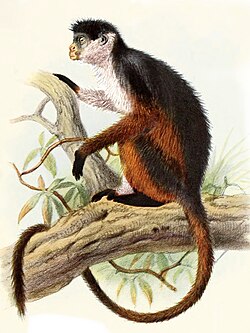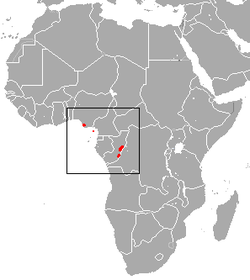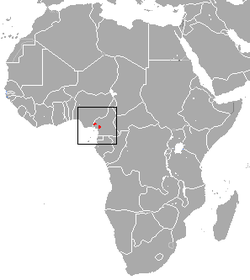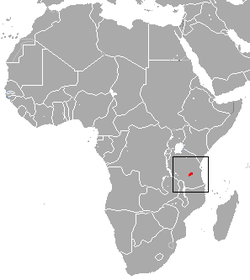| Common name | Scientific name and subspecies | Range | Size and ecology | IUCN status and estimated population |
|---|
| Bouvier's red colobus
| P. bouvieri
Rochebrune, 1887 | Congo (in purple on left)
 | Size: 41–70 cm (16–28 in) long, plus 42–80 cm (17–31 in) tail [22]
Habitat: Forest [23]
Diet: Fruit, seeds, and leaves [22] | EN
Unknown  [23] [23]
|
|---|
| Foa's red colobus
| P. foai
(Pousargues, 1899) | Congo (in black, bottom right)
 | Size: 41–70 cm (16–28 in) long, plus 42–80 cm (17–31 in) tail [22]
Habitat: Forest [24]
Diet: Fruit, seeds, and leaves [22] | EN
Unknown  [24] [24]
|
|---|
| Lang's red colobus
| P. langi
(J. A. Allen, 1925) | Congo
 | Size: 41–70 cm (16–28 in) long, plus 42–80 cm (17–31 in) tail [22]
Habitat: Forest [25]
Diet: Fruit, seeds, and leaves [22] | EN
Unknown  [25] [25]
|
|---|
| Lomami red colobus
| P. parmentieri
(Colyn & Verheyen, 1987) | Congo
 | Size: 41–70 cm (16–28 in) long, plus 42–80 cm (17–31 in) tail [22]
Habitat: Forest [26]
Diet: Fruit, seeds, and leaves [22] | EN
Unknown  [26] [26]
|
|---|
| Miss Waldron's red colobus
| P. waldronae
(Hayman, 1936) | Western Africa
 | Size: 47–63 cm (19–25 in) long, plus 52–75 cm (20–30 in) tail [27]
Habitat: Forest [28]
Diet: Fruit, seeds, leaves, buds, and flowers [27] | CR
Unknown  [28] [28]
|
|---|
| Niger Delta red colobus
| P. epieni
(Grubb & Powell, 1999) | Western Africa | Size: 41–70 cm (16–28 in) long, plus 42–80 cm (17–31 in) tail [22]
Habitat: Forest [29]
Diet: Fruit, seeds, and leaves [22] | CR
Unknown  [29] [29]
|
|---|
| Oustalet's red colobus
| P. oustaleti
(Trouessart, 1906) | Congo (in green)
 | Size: 41–70 cm (16–28 in) long, plus 42–80 cm (17–31 in) tail [22]
Habitat: Forest [30]
Diet: Fruit, seeds, and leaves [22] | VU
Unknown  [30] [30]
|
|---|
| Pennant's colobus  | P. pennantii
(Waterhouse, 1838) | Western Africa
 | Size: 53–63 cm (21–25 in) long, plus 60–70 cm (24–28 in) tail [31]
Habitat: Forest [32]
Diet: Leaves and shoots, as well as seeds and fruit [31] | CR
Unknown  [32] [32]
|
|---|
| Preuss's red colobus  | P. preussi
Matschie, 1900 | Western Africa
 | Size: 41–70 cm (16–28 in) long, plus 42–80 cm (17–31 in) tail [22]
Habitat: Forest [33]
Diet: Fruit, seeds, and leaves [22] | CR
Unknown  [33] [33]
|
|---|
| Semliki red colobus
| P. semlikiensis
(Colyn, 1991) | Congo (in dark blue on right)
 | Size: 41–70 cm (16–28 in) long, plus 42–80 cm (17–31 in) tail [22]
Habitat: Forest [34]
Diet: Fruit, seeds, and leaves [22] | VU
Unknown  [34] [34]
|
|---|
| Tana River red colobus  | P. rufomitratus
(Peters, 1879) | Kenya | Size: 45–67 cm (18–26 in) long, plus 52–80 cm (20–31 in) tail [35]
Habitat: Forest, shrubland, and inland wetlands [36]
Diet: Leaves, fruit, and seeds, as well as flowers [35] | CR
Unknown  [36] [36]
|
|---|
| Thollon's red colobus
| P. tholloni
(A. Milne-Edwards, 1886) | Congo (in orange)
 | Size: 41–70 cm (16–28 in) long, plus 42–80 cm (17–31 in) tail [22]
Habitat: Forest [37]
Diet: Leaves, fruit, and seeds, as well as flowers [37] | VU
Unknown  [37] [37]
|
|---|
| Udzungwa red colobus  | P. gordonorum
Matschie, 1900 | Southeastern Africa
 | Size: 41–70 cm (16–28 in) long, plus 42–80 cm (17–31 in) tail [22]
Habitat: Forest [38]
Diet: Fruit, seeds, and leaves [22] | VU
35,000  [38] [38]
|
|---|
| Ugandan red colobus  | P. tephrosceles
(Elliot, 1907) | Eastern Africa
 | Size: 41–70 cm (16–28 in) long, plus 42–80 cm (17–31 in) tail [22]
Habitat: Forest and savanna [39]
Diet: Fruit, seeds, and leaves [22] | EN
Unknown  [39] [39]
|
|---|
| Western red colobus  | P. badius
(Kerr, 1792)
| Western Africa
 | Size: 45–67 cm (18–26 in) long, plus 52–80 cm (20–31 in) tail
Habitat: Forest and savanna [40]
Diet: Leaves, seeds, unripe fruit, and shoots [41] | EN
Unknown  [40] [40]
|
|---|
| Zanzibar red colobus  | P. kirkii
(Gray, 1868) | Eastern Africa
 | Size: 41–70 cm (16–28 in) long, plus 42–80 cm (17–31 in) tail [22]
Habitat: Forest and shrubland [42]
Diet: Leaves, fruit, and seeds, as well as flowers [43] | EN
5,900  [42] [42]
|
|---|





















